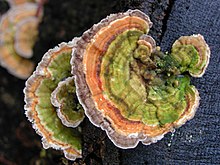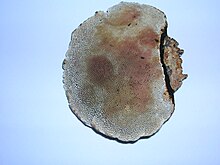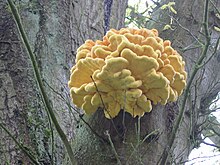Bracket fungus
This article needs additional citations for verification. (November 2009) |





Bracket fungi, or shelf fungi, are among the many groups of fungi that comprise the phylum Basidiomycota. Characteristically, they produce shelf- or bracket-shaped fruiting bodies called conks that lie in a close planar grouping of separate or interconnected horizontal rows. Brackets can range from only a single row of a few caps, to dozens of rows of caps that can weigh several hundred pounds. They are mainly found on trees (living and dead) and coarse woody debris, and may resemble mushrooms. Some form annual fruiting bodies while others are perennial and grow larger year after year. Bracket fungi are typically tough and sturdy and produce their spores, called basidiospores, within the pores that typically make up the undersurface.
Classification
Because bracket fungi are defined by their growth form rather than phylogeny, the group contains members of multiple clades. The term classically was reserved for polypores, however molecular studies have revealed some odd relationships. The beefsteak fungus, a well known bracket fungus, is actually a member of the agarics. Other examples of bracket fungi include the sulphur shelf, birch bracket, dryad's saddle, artist's conk, and turkey tail. The name Polypores is often used for a group that includes many of the hard or leathery fungi, which often lack a stem, growing straight out of wood.
The group includes many different shapes and forms that are common in the tropical forests, including the hard 'cup fungi' and the 'shell', 'plate' and 'bracket' fungus commonly found growing off logs and still standing dead trees.
Ecology
Bracket fungi often grow in semi-circular shapes, looking like trees or wood. They can be parasitic, saprotrophic, or both. One of the more common genera, Ganoderma, can grow large thick shelves that may contribute to the death of the tree, and then feed off the wood for years after. Their hardiness means they are very resilient and can live for quite a long time, with many species even developing beautiful multi-coloured circles of colour that are actually annual growth rings.
Uses
Some species of bracket fungi are cultivated for human consumption or medicinal use* - (citation needed). They can also be used as a wick in an oil/fat lamp. Use a shell, turtle shell, or non-burning oil/fat container. Prop fungus up using three little rocks. Place oil or fat in container. Once Bracket Fungus turns black and has absorbed oil it is ready to light.
See also
- Amadou, a flammable substance prepared from bracket fungi
- Pleurotoid fungi have a similar form, but are gilled
- Wood-decay fungus
